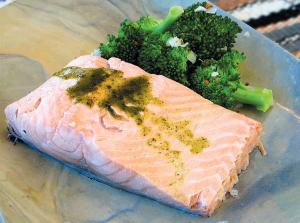Lenten meals don’t have to give up flavor
This coming Wednesday marks the beginning of Lent, a season of penitence and prayer in the Christian tradition. During this period of 40 days leading up to Easter, observers will fast and avoid eating meat on specific days of the week. Many people will give up a food treat like chocolate or ice cream, while others will replace their favorite activity with charity work or community service.
When we were growing up, Friday dinner entrees during Lent never varied: fish. Delectable alternatives ranged from frozen fish sticks to tuna noodle casserole (a dish Jack has vowed never to eat again). Whether our mothers didn’t know how to cook other types of fish or they had limited choices at local markets, we didn’t enjoy the same variety of fresh seafood alternatives available today.
With all the health benefits associated with eating fish, maybe the next five weeks would be a good time to incorporate more seafood in our diets. But first, a caveat – not all fish are created equal. Certain varieties of larger fish (such as swordfish) are high on the food chain and can also have high levels of mercury (see sidebar). For the best heart-healthy choices, look for seafood that is high in omega-3 fatty acids, such as mackerel, anchovies and sardines.
Another less-than-ideal feature of serving seafood is the aroma that often lingers in the kitchen, especially if you’ve pan-seared or broiled it (although the cats don’t complain). You can solve this problem by grilling on the outdoor barbecue or take a lesson from breakfast and try poaching. Not to be confused with boiling (which would give your fish the consistency of a hockey puck), poaching entails gently simmering.
A combination of briefly marinating the fish before cooking and using stock as the simmering liquid infuses additional flavor. The salmon in the photo was tossed in a mixture of lemon juice and sea salt, then simmered in seasoned chicken stock. After about 10 minutes. the salmon was tender, moist and ready to serve with a drizzle of pesto sauce for a bright touch of color on the plate. If you’re keeping meat out of your diet, herb-infused wine would work equally well as the stock in this recipe.
Another surprising poaching liquid is olive oil. The key is keeping the oil at exactly the right temperature (about 120 F is the target), and a thermometer is essential. Even if you have a small “simmer burner” on your gas cooktop, you might need to pull the pan off the heat for a moment if the temperature starts to creep up. Or, you can poach the filet in the oven, after layering it with lemon, parsley and olive oil, as in the recipe below.
Whether or not you give up a pleasure for Lent, you can add a treat to the dinner table with adelicious serving of poached fish.
Skillet Poached Salmon
Juice of 1 lemon
1/8 t sea salt
1/2 lb salmon filet
2 C chicken stock
1 chopped shallot
Combine lemon juice and salt in a shallow bowl. Add salmon, skin side up, and marinate for about 15 minutes. Pour chicken stock into a small skillet that can hold the fish in a single layer. Add shallots and heat until almost at a simmer. Slide the salmon into the skillet, skin side down, and cook until flesh flakes easily, about 10 minutes (or less, depending upon thickness). Yield: 2 servings.
Olive Oil Poached Halibut
2 C olive oil
3 sprigs rosemary
juice of 1 lemon
1/2 lb halibut filet
1/8 t sea salt
Place the olive oil in a small skillet that can hold the fish in a single layer. Add the rosemary and lemon juice; heat over medium for about 5 minutes. Remove from heat and cool. Rinse and dry the filet; cut in half and sprinkle with salt.
Keeping track with a candy thermometer, heat the oil to 120 F over very low flame. Using a spatula, slide the fish into the pan. Maintain the temperature at 120 F, removing the pan from the heat as needed. Continue cooking until fish flakes easily, about 20 minutes.
Oven Poached Cod
1/2 lb cod filet
1 lemon
1/4 C chopped parsley
3 T capers
1 C olive oil
Preheat the oven to 250F. Thinly slice the lemon and arrange half the slices in an 8-by-8-inch baking dish. Place the fish on the lemons; sprinkle with capers and parsley. Pour in olive oil and arrange remaining lemon slices over the fish. Bake until flesh flakes easily, about an hour.























































